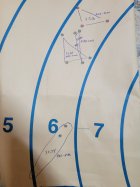Excellent. You have given your actual experience. I will say that in my experience that maximizing velocity is not the be all end all for most competition shooting that I know of. If you shot several five shot groups with flags and under favorable conditions, how did your 36" barrels group and what caliber were they chambered for? On the .22s that information has been out there for quite a while, but I tend to keep RF discussions in a separate category, since there are quite a few significant differences. Getting back to the real long heavy barrels, I am pretty sure in the long range benchrest game, barrel blocks have solved a lot of those problems, although I should probably note that the whole concept has probably become a bit dated since the current 600 yard HG record was shot with a 26" barrel.
Sorry this diverged off topic. About half end up as .284’s and half as Saums. I normally order 8 blanks at a time that taper to an inch from a 1.45” x -3-4” breech, but the length has varied 5 inches or so over the years, and the twists vary from 8 to 9, with most being 8.5.
The 36’s are assured of real set back potential, but there are some uncertainties as well. The first uncertainty is whether all bullets can survive them. (They cannot under some conditions, in Saums, but all can in .284’s). The second was whether they would shoot faster or not, and some loads are actually slightly slower, while others still see a gain, in a saum. In a .284, they all still see a gain, regardless of powder or bullet that I’ve tried. The longer .284 powder column I believe slows and lowers, the peak of powder combustion.
The third was improved accuracy if velocity rose, and I’ll say no, not yet that I see. This isn’t fully confirmed but so far scores are not higher with them. I didn’t know if I’d see more copper fouling at the front, and there is. As with a fast .22 centerfire those jackets get hot at the end of the barrel.
Gun handling in the bags is nice though, with such a long barrel and weight, up there. The extreme length seems to slow down or better absorb all the felt firing disturbances.
They weigh more than half of the 10kg limit at that length, but because of their taper, most of that weight is close to the action, not to the muzzle. With heavy barrels on a rest, I do prefer to find the area of stock that sits on the front bag, then utilize a small amount of compressible material between the stock and barrel that absorbs resonance and puts a modest upward lift on the barrel, such that viewed from the side, the barrel would press down on a soft shim, which would press on the stock where the stock sits on the rest.











